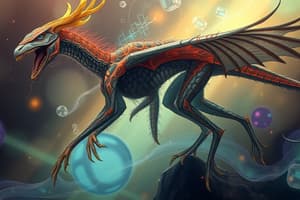Podcast
Questions and Answers
What is taxonomy?
What is taxonomy?
- The classification of organisms and assigning them a name (correct)
- The study of ecosystems
- The process of natural selection
- The study of animal behavior
What does binomial nomenclature refer to?
What does binomial nomenclature refer to?
- A way to classify ecosystems
- A one-part naming system
- The study of cellular structures
- A classification system with a two-part scientific name (correct)
What is a genus?
What is a genus?
A group of closely related species.
What is a taxon?
What is a taxon?
What is a family in biological classification?
What is a family in biological classification?
What is an order in taxonomy?
What is an order in taxonomy?
What is a phylum?
What is a phylum?
What is a kingdom?
What is a kingdom?
What is a class in taxonomy?
What is a class in taxonomy?
What does phylogeny refer to?
What does phylogeny refer to?
What is evolutionary classification?
What is evolutionary classification?
What are derived characters?
What are derived characters?
What is a cladogram?
What is a cladogram?
What is a molecular clock?
What is a molecular clock?
What is the most inclusive taxonomic category?
What is the most inclusive taxonomic category?
What characterizes the domain Bacteria?
What characterizes the domain Bacteria?
What is Eubacteria?
What is Eubacteria?
What defines the domain Archaea?
What defines the domain Archaea?
What is Archaebacteria?
What is Archaebacteria?
What is the domain Eukarya?
What is the domain Eukarya?
What characterizes the kingdom Protista?
What characterizes the kingdom Protista?
What does the kingdom Fungi consist of?
What does the kingdom Fungi consist of?
What is Plantae?
What is Plantae?
What characterizes the kingdom Animalia?
What characterizes the kingdom Animalia?
Flashcards
Taxonomy
Taxonomy
The science of classifying organisms and assigning universally accepted names.
Binomial nomenclature
Binomial nomenclature
A two-part naming system for species, including the genus and species name.
Genus
Genus
A group of closely related species sharing common characteristics.
Taxon
Taxon
Signup and view all the flashcards
Family
Family
Signup and view all the flashcards
Order
Order
Signup and view all the flashcards
Phylum
Phylum
Signup and view all the flashcards
Kingdom
Kingdom
Signup and view all the flashcards
Class
Class
Signup and view all the flashcards
Phylogeny
Phylogeny
Signup and view all the flashcards
Evolutionary classification
Evolutionary classification
Signup and view all the flashcards
Derived characters
Derived characters
Signup and view all the flashcards
Cladogram
Cladogram
Signup and view all the flashcards
Molecular clock
Molecular clock
Signup and view all the flashcards
Domain
Domain
Signup and view all the flashcards
Bacteria
Bacteria
Signup and view all the flashcards
Eubacteria
Eubacteria
Signup and view all the flashcards
Archaea
Archaea
Signup and view all the flashcards
Archaebacteria
Archaebacteria
Signup and view all the flashcards
Eukarya
Eukarya
Signup and view all the flashcards
Protista
Protista
Signup and view all the flashcards
Fungi
Fungi
Signup and view all the flashcards
Plantae
Plantae
Signup and view all the flashcards
Animalia
Animalia
Signup and view all the flashcards
Study Notes
Taxonomy and Classification
- Taxonomy involves the classification of organisms and assigning universally accepted names.
- Binomial nomenclature is a two-part naming system for each species, including the genus and species name.
- Genus refers to a group of closely related species sharing common characteristics.
- A taxon is any group or level of classification in taxonomy, such as species, genus, or family.
- Family is a higher taxonomic group that includes multiple genera with shared traits.
Higher Taxonomic Categories
- Order is a broader category encompassing similar families.
- Phylum consists of closely related classes, which group organisms sharing significant common characteristics.
- Kingdom is a large taxonomic category grouping related phyla together.
- Class is a classification level that groups similar orders of organisms.
Evolutionary Relationships
- Phylogeny represents the evolutionary relationships among different organisms.
- Evolutionary classification involves grouping organisms based on their evolutionary history and shared ancestry.
- Derived characters are traits appearing in recent parts of a lineage, absent in older members.
- A cladogram is a diagram depicting evolutionary relationships and shared derived traits among organisms.
Molecular and Taxonomic Models
- A molecular clock estimates the time that two species have been evolving separately by comparing their DNA.
- The domain is the most inclusive taxonomic category, larger than a kingdom.
Domains and Kingdoms
- Bacteria is a domain of unicellular prokaryotes with cell walls containing peptidoglycan.
- Eubacteria refers to a kingdom of unicellular prokaryotes with peptidoglycan cell walls.
- Archaea encompasses unicellular prokaryotes lacking peptidoglycan in their cell walls.
- Archaebacteria is the kingdom of unicellular prokaryotes with unique characteristics compared to Eubacteria.
- Eukarya is the domain that includes all organisms with nuclei, comprising protists, plants, fungi, and animals.
Specific Kingdoms
- Protista is a kingdom of eukaryotes not classified as plants, animals, or fungi, indicating great diversity.
- Fungi includes organisms that are heterotrophic, often obtaining energy from decomposing organic matter.
- Plantae consists of multicellular photosynthetic autotrophs, characterized by cellulose in their cell walls.
- Animalia encompasses multicellular eukaryotic heterotrophs whose cells lack cell walls, showing complex structures and behaviors.
Studying That Suits You
Use AI to generate personalized quizzes and flashcards to suit your learning preferences.
Description
Explore the concepts of taxonomy and the classification of organisms through this quiz. Learn about binomial nomenclature, taxonomic ranks, and the relationships among different life forms. Test your knowledge on the hierarchical structure from species to kingdom.




